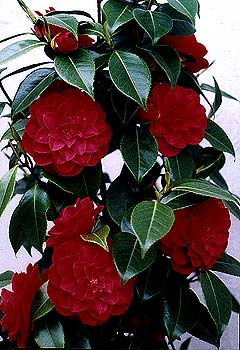 Camellia japonica 'Brilliant'
Camellia japonica 'Brilliant'
"Camelia-Petal
Fell in silent dawn
Spilling
A water jewel."
-Matsuo Basho,
1644-1694
1644-1694
Camellia japonica 'Brilliant' is in our shade garden. It was once a common offering, but is no longer often listed in catalogs of camellias.
It stood about head-high in 2002; its was over six feet tall two years later. It is only a couple feet wide, a very upright column. It could someday nearly double it's height, & will eventually need some trimming to keep it off the path, though 'Brilliant' is notably compact & doesn't spread as wide as do many camellias.
By April Fools Day the buds are gigantic & threatening to open but take their time about getting the job done. The photo was taken late in April during its first year in the ground. Large evergreen leaves, & large roseform double-flowers to match, 'Brilliant' is just one of thousands of named varieties.
The camellia has been in cultivation for centuries in Japan, Korea, China & India. They are named for a Moravian Jesuit priest, Geoy Josef Kanel, whose name latinised became Camellias. He lived & preached in the Phillipine Islands where he died in 1706.
Drought resistant once established, but preferring moist cool soil, Camellia roots are shallow & very susceptible to overheating if exposed to direct sun. It is important that crown & trunk are always free of dirt or debris, nor should the spent blossoms be left on the ground as mulch, as camellias are susceptible to fungus if the roots are stressed in any way.
II. AND THE LANGUAGE OF FLOWERS
Victorians of the United Kingdom & much of the Commonwealth, plus France & the United States, possessed a once well-known "language of flowers." This permitted people to make allusions in correspondence (especially love letters) or to send flowers of particular meaning so that things that should not be openly stated could nevertheless be conveyed.
In the language of flowers, a crocus meant "do not hurt me," a white rosebud warned that someone is too young for love, a full red rose meant beauty, apple blossoms meant "good luck to you," bachelor buttons meant devotion, ivy is emblematic of marriage, hazels represent reconciliation, a carnation meant "I will never forget you." Many plants even today have names alluding to these former meanings, as the forget-me-not, which means remembrance.
This type of secret language, of such benefit especially to lovers, but could also provide varied messages of shared grief when flowers were sent to funerals, originated in Constantinope in the 1600s, & initially filtered into the west bit by bit in translations of Persian poetry.
This language was eventually introduced wholesale from Turkey into England, France & America. Shortly after her death, the personal letters of Lady Mary Wortley Montagu were published, in 1763, full of her observations earlier in the century as the young wife of England's ambassador to Turkey, including an outline of the meanings of flowers. Seigneur Aubry de la Mottraye had likewise learned of this literary tradition while living in exile in Turkey, describing it in his French memoir of 1727, which became popular in England. B. Delachenaye's Abecedaire de Flore ou langage des fleurs (1810) & Charlotte de Latour's Le Langage des Fleurs (1819, published in English a year later) began a veritable genre of language-of-flowers books that penetrated western society very deeply. American "Lady's magazines" of the era tended to be written, edited, & published by women, so this floral language was widely disseminated by magazine editors, including by Sarah Josepha Hale whose Flora's Interpreter (1832) was perpetually in print for the next three decades.
Every school-girl, shop-girl, or lady of refinement knew this language, which permitted much to be said in letters or diaries that was not explicit & might be too daring to express more boldly. Within this tradition, a red camellia meant "alas, my broken heart" or "I admire you greatly" or "you possess inward beauty & goodness."
In Japan, where the Camellia or Tsubaki has such a long-gardened history, the language of flowers is older than in the west. Camellias are sometimes said to represent business success, virtue, happiness, fidelity, luxury, tastefulness, & a life concluding in the ease of retirement. But that is in great part a modern imposition or overlay, because formerly the camellia, akin to cherry blossoms which symbolized evanescense, was symbolic of a short life lived in a blaze of glory, or in faithfulness to a lord even in the face of sure death.
While the camellia was an important fixture in the garden of someone of the samurai class who admired an honorable death, among farmers & merchants it was not so well liked. Basil Hall Chamberlain in his classic work Japanese Things (1904), introducing Japanese culture to a western readership, noted the following: "The camellia is neglected because it is considered unlucky. It is considered unlucky because its red blossoms fall off whole in a way which reminds people of decapitated heads."
Chamberlain overstated somewhat, for in the Heian court period so gloriously captured by Lady Murasaki Shikibu in A Tale of Genji, the "sudden death" which camellias symbolized could as well be the sudden death of dreams, illusions, & love affairs. There was tragedy in camellias because they are simultaneously things of great beauty & of transience, indicative of the "sadness of things" in Buddhist philosophy, & it is out of such contradictions that all beauty arises.
The evergreen leaves & woody structure of camellias had an entirely different connotation, given that the leaves, unlike the flowers, were eternally present. The Japanese emperior possessed a staff made of camellia wood because of its power to ward off evil spirits. The shrubs in or out of bloom were indicative of the nobility & spirituality of reasoned discourse & thought, & of scholarliness or of meditative endeavors such as tea ceremony.